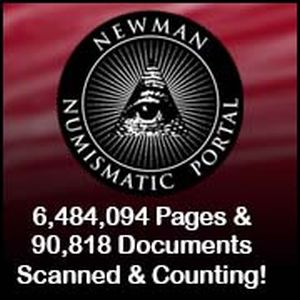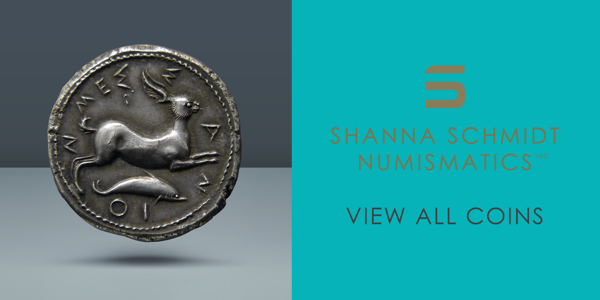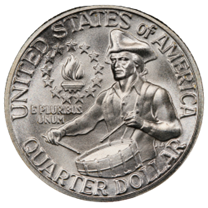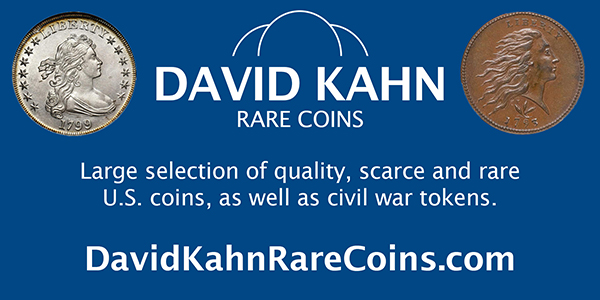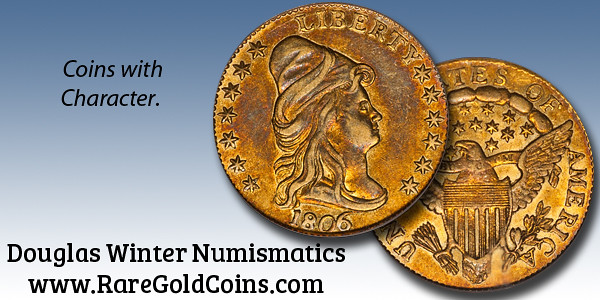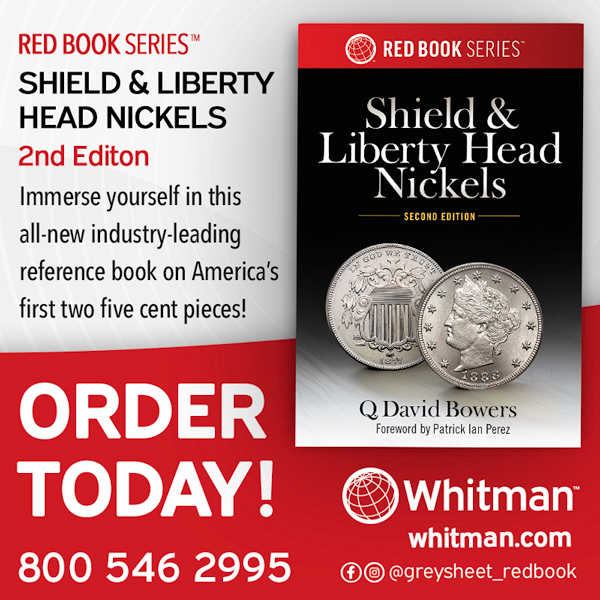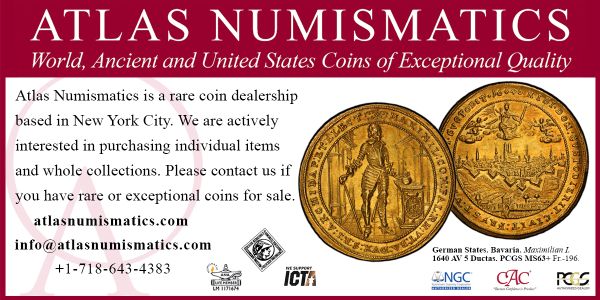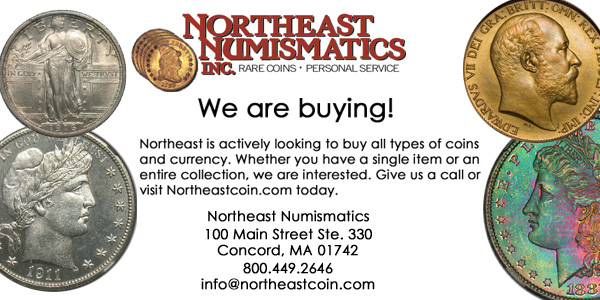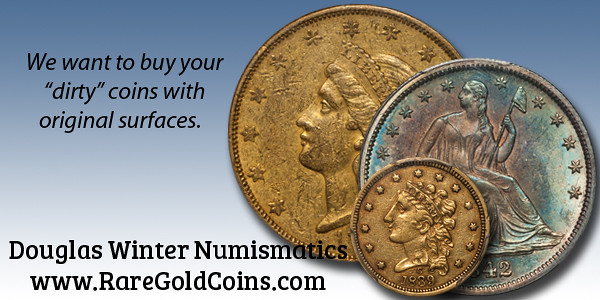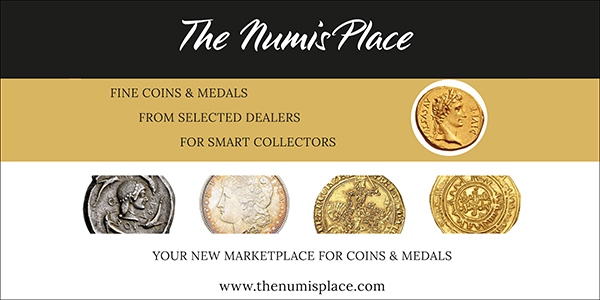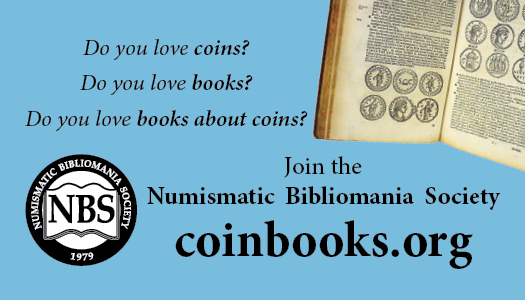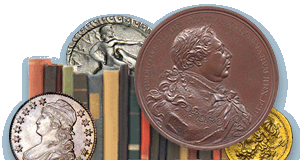
Visit our NBS Sponsors


About UsThe Numismatic Bibliomania Society is a non-profit association devoted to the study and enjoyment of numismatic literature. For more information please see our web site at coinbooks.org SubscriptionsThose wishing to become new E-Sylum subscribers (or wishing to Unsubscribe) can go to the following web page link MembershipThere is a membership application available on the web site Membership Application To join, print the application and return it with your check to the address printed on the application. Print/Digital membership is $40 to addresses in the U.S., and $60 elsewhere. A digital-only membership is available for $25. For those without web access, write to: Jeff Dickerson, Treasurer AsylumFor Asylum mailing address changes and other membership questions, contact Jeff at this email address: treasurer@coinbooks.org SubmissionsTo submit items for publication in The E-Sylum, write to the Editor at this address: whomren@gmail.com BUY THE BOOK BEFORE THE COINSale Calendar
|
- WAYNE'S WORDS: THE E-SYLUM JUNE 15, 2025
- NEW BOOK: SOUTHERN CROSS OF HONOR, 2ND EDITION
- BANKNOTE BOOK OLDENBURG CHAPTER PUBLISHED
- PERIODICAL: ASIAN NUMISMATICS NO. 53
- U.S. RARITIES CENSES ON THE NEWMAN PORTAL
- VIDEO: LINCOLN CENT VARIETIES
- ANA ANNOUNCES 2025 SERVICE AWARDS
- THE GLORIOUS SS CENTRAL AMERICA COIN FOSSIL
- NOTES FROM E-SYLUM READERS: JUNE 15, 2025
- STUDENTS PRACTICE COIN STRIKING
- VOCABULARY TERM: RIBBON CIRCLET
- JERRY L. MORGAN (1948-2024)
- SOPHIA HOLMES, FIRST BLACK FEMALE FED
- MICHAEL DOLLEY AND IRISH NUMISMATICS
- 2025 BANS SPRING CONGRESS
- NOONAN'S JUNE 2025 BANKNOTE SALE SELECTIONS
- KUENKER AUCTION SALE 426
- KUENKER: GAMING COUNTERS AND NUMISMATICS
- CONFUSING IMPERIAL NAMES ON ROMAN COINS
- ROMAN SILVER COIN HOARDS IN ROMANIA
- CAROL ROSS ANCIENT COIN COLLECTION SOLD
- PAUL NARCE COIN COLLECTION SOLD
- UNIQUE 7TH CENTURY BRITISH COIN FOUND
- ENGLISH CIVIL WAR SILVER HOARD FOUND
- IMAGES OF SAN JOSE GALLEON GOLD COINS
- WILL CUBA ISSUE HIGH DENOMINATION COINS?
- JERSEY UNDECIDED ON KING'S IMAGE
- WHEN COINS ARE INHERITED
- LOOSE CHANGE: JUNE 15, 2025
- COLLECTING LICENSE PLATES
- FEATURED WEBSITE: RARCOA
- ABOUT THIS ISSUE: JUNE 15, 2025
Content presented in The E-Sylum is not necessarily researched or independently fact-checked, and views expressed do not necessarily represent those of the Numismatic Bibliomania Society.
WAYNE'S WORDS: THE E-SYLUM JUNE 15, 2025
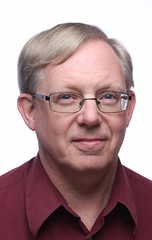 New subscribers this week include:
Greg Darnstaedt and Howard Curtis.
Welcome aboard! We now have 7,228 subscribers.
New subscribers this week include:
Greg Darnstaedt and Howard Curtis.
Welcome aboard! We now have 7,228 subscribers.
Thank you for reading The E-Sylum. If you enjoy it, please send me the email addresses of friends you think may enjoy it as well and I'll send them a subscription. Contact me at whomren@gmail.com anytime regarding your subscription, or questions, comments or suggestions about our content.
This week we open with two new books and a periodical, updates from the Newman Numismatic Portal and the ANA, notes from readers, and more.
Other topics this week include the Southern Cross of Honor, Asian numismatics, Lincoln Cent varieties, ribbon circlets, Sophia Holmes, Michael Dolley, auction previews, coin hoards and collections, coins of the San Jose shipwreck, and RARCOA.
To learn more about banknotes of Oldenburg, Germany, important rarities in the U.S. coinage series, the ANA's Medal of Merit and Adna G. Wilde Memorial Award, three-cent checks, Jerry Morgan, Ben Dreiske, the Spring Congress of the British Association of Numismatic Societies, gaming counters, a man dancing a jig, decisions contemplated in Cuba and Jersey, cryptocurrency ATMs, the Sheriff of Nottingham, and the Fishpool Hoard Mystery, read on. Have a great week, everyone!
Wayne Homren
Editor, The E-Sylum
NEW BOOK: SOUTHERN CROSS OF HONOR, 2ND EDITION
A new edition of Peter Bertram's book on the Southern Cross of Honor has been published. -Editor
 The Southern Cross of Honor: Historical Notes and Trial List of Varieties, 2nd Ed.
The Southern Cross of Honor: Historical Notes and Trial List of Varieties, 2nd Ed.
Little Greybook #2a begins with a history of the Southern Cross of Honor, followed by detailed illustrations of the thirteen varieties identified by the author. This is followed by an examination of several forgeries and reproductions which are unfortunately also out there. It then takes a look at the four types of applications used by eligible individuals to apply to receive a Southern Cross of Honor, followed by a gallery of a few selected Crosses. Lastly the book lists some 574 veterans who received their Southern Cross of Honor on April 26th, 1900, the first day of the bestowals - 300 in Athens, Georgia, and 274 in Atlanta.
This second edition is primarily for those who perhaps missed the first edition in 2003, or just recently became interested in the subject. Most of the new information herein is mainly clarifications of the reproductions and forgeries.
BANKNOTE BOOK OLDENBURG CHAPTER PUBLISHED
A new chapter of The Banknote Book has been published by Whitman–CDN. Written by Mark Irwin and Owen Linzmayer, the 4-page catalog covers notes issued in Oldenburg, Germany from 1869 to 1870. -Editor
PERIODICAL: ASIAN NUMISMATICS NO. 53
Here are the contents of the latest issue of Numismatique Asiatique (Asian Numismatics). -Editor
 EDITORIAL
EDITORIAL
Les Sixièmes Rencontres de Numismatique Asiatique en 2025
The Sixth Meetings of Numismatique Asiatique in 2025
CHINA
Research on Machine Minting of Fuzhou Shipping Bureau in
A Monetary History of China
by Jun Li
THAILAND
Reflections of Phibun Songkhram Cultural Reforms on coins of Thailand
by Valerii V. Gaganov
CAMBODGE
Deux types remarquables de monnaies cambodgiennes à l'oiseau Hamsa
par Alain Escabasse
Archives / CHINA
Coins of the Republic of China by Guiseppe Ros
by Craig Greenbaum
U.S. RARITIES CENSES ON THE NEWMAN PORTAL
The latest addition to the Newman Numismatic Portal is a collection of photos of important U.S. rare coins. Project Coordinator Len Augsburger provided this report. Thank you. -Editor
Saul Teichman Adds U.S. Rarities Censes to Newman Portal
Recently added to Newman Portal is a group of photo files compiled by Saul Teichman, which serve as condition censes for important rarities in the U.S. coinage series. This follows on to Teichman's previous work on the U.S. pattern and territorial gold series. The collected work represents several hundred short monographs in total and serves to quickly identify the best coins of a given issue, or, in many cases, all the coins of a given issue. Teichman is a relentless researcher and has mined auction catalogs, institutional collections, and his own numismatic network to develop these richly detailed guides.
Image: 1873-CC No Arrows quarter, one of five known examples, NGC XF40.
VIDEO: LINCOLN CENT VARIETIES
The David Lisot Video Library on the Newman Numismatic Portal can be found at:
https://nnp.wustl.edu/library/multimediadetail/522852
We highlight one of his videos each week in The E-Sylum. Here's one from 2009 with Sol Taylor speaking about Lincoln cent varieties. -Editor
ANA ANNOUNCES 2025 SERVICE AWARDS
The American Numismatic Association has announced recipients of this year's service awards. Here's the press release. -Editor
Awards for Dedication to Hobby
Every year, the American Numismatic Association (ANA) recognizes members who go above and beyond with their service and dedication to numismatics. The following awards, presented at the World's Fair of Money®, will be awarded during the Member Awards & Donor Celebration, Thursday, August 21 from 3-4:30 p.m. in Ballroom A of the Oklahoma City Convention Center.
The ANA's Medal of Merit honors individuals who have dedicated years of service to the Association and have worked to promote the hobby. This year's recipients are Wayne Homren, Patrick McBride, and Robert Mellor.
THE GLORIOUS SS CENTRAL AMERICA COIN FOSSIL
Regarding the recent SS Central America exhibit at the PAN Show, Bob Evans writes:
"We had a great time with this exhibit. It's wonderful to get to talk in front of some of my favorite artifacts. Greg has collected pieces with great stories.
"By the way, it was more than two tons of gold."
We've updated the archived version of my Diary article to correct my misstatement of the amount of gold recovered from the shipwreck. The articles featuring the SS Central America story were my favorites from last week, as was the image of the "coin fossil" Bob described in his blog.
In very rare instances large pieces of blackish (oxygen-poor) rust spall off the coins and ingots, showing perfect reverse impressions of the gold surface... making a perfect duplication of the original die. A "coin fossil." Lustrous rust!
-Editor
Bob adds:
"Thanks for acknowledging this remarkable photo. I had the piece with me when I spoke at Central States in Cincinnati a few years back, and David Heinrich was honing his coin photography skills, with a really nice setup at his house, where he graciously offered to get a good photo of it.
"Did he ever?!
"The piece is very dark, composed as it is of very dark iron minerals, but the mineral cast of the coin surface is so microscopically precise that the flow lines on the original die, struck into the coin surface, are transferred to the rust in such detail that it shows mint luster. David's lens and lighting captured it beautifully.
"Incredible. An amazing combination of art and nature."
I don't need an excuse to rerun that photo. It was a slam-dunk for Image of the Week last week. Maybe we should start an Image of the Year award. Wow. -Editor
To read the earlier E-Sylum articles, see:
TREASURE TALK WITH BOB EVANS, EPISODE 5.2
(https://www.coinbooks.org/v28/esylum_v28n23a16.html)
WAYNE'S NUMISMATIC DIARY: JUNE 1, 2025, PART THREE
(https://www.coinbooks.org/v28/esylum_v28n23a21.html)
NOTES FROM E-SYLUM READERS: JUNE 15, 2025
Bicentennial Stamp and Coin Drummer Design
Wayne Pearson writes:
"I just purchased this stamp. I never knew it existed. The bicentennial quarter really does look like it."
Indeed it does! Thanks. -Editor
Other topics this week include Three Cent checks, and the ANA Medal of Merit. -Editor
STUDENTS PRACTICE COIN STRIKING
Students at King's College London are learning how coins were made during the Roman period. -Editor
PhD student Francesca Lam-March invited students to take part in the coin striking workshop as part of her project to emulate how coins were made during the Roman period.
Francesca describes the project aims:
"The project will use experimental archaeology to assess how the depth of engraving and metallurgy of bronze coin dies impacts coin portraits on bronze blanks. It will shed light on the processes and decisions made by those casting and engraving a die. It addresses the significant disparity in portrait styles in Roman provincial coinage for which there is no good explanation. By choosing to focus on the die rather than the often-studied coins, a deeper understanding of the struck image can be gained."
VOCABULARY TERM: RIBBON CIRCLET
Here's another entry from Dick Johnson's Encyclopedia of Coin and Medal Terminology. I added the image. -Editor
Riband Circlet or Ribbon Circlet. A design element completely encircling a center device, as a narrow band or belt which usually contains a motto or other lettering. Riband circlets are popular design elements in coats of arms and on decorations where the circlet sometimes has a design like a buckle at the bottom of the ribbon as if tying the ends of the ribbon together. So important is this band of lettering that it is seldom found without some wording. Most numismatic writers prefer to retain the early spelling "riband" since it was used thusly for so many years. However, "ribbon circlet," particularly in America, is just as correct.
JERRY L. MORGAN (1948-2024)
E-Sylum Feature Writer and American Numismatic Biographies author Pete Smith submitted this article on dealer Jerry Morgan. Thank you. -Editor
 Sometimes the death of a numismatic author may go unnoticed in The E-Sylum. Sometimes I can
correct that. I believe that The E-Sylum does more than just report news. It becomes an archive
for information that may be reviewed in the future.
Sometimes the death of a numismatic author may go unnoticed in The E-Sylum. Sometimes I can
correct that. I believe that The E-Sylum does more than just report news. It becomes an archive
for information that may be reviewed in the future.
Jerry L. Morgan was born in Missouri on December 3, 1948, the son of David Franklin Morgan (1927-2011) and Anita Marie Root (1930-2024). His mother outlived him.
He was married to Nancy Price Rush and they had a son, Clayton. Jerry graduated with a degree in business from Southeast Missouri State University and served in the National Guard.
The life story of Jerry Morgan is a bit fuzzy during 1975 to 1996. I suspect that the subject of this story was employed in sales and marketing outside numismatics and that another Jerry Morgan was an active coin show promoter in the Denver area.
SOPHIA HOLMES, FIRST BLACK FEMALE FED
I could only find one brief mention in the E-Sylum archives about Sophia Holmes, the first Black woman hired into the federal government. Here's an excerpt from a Numismatic News article by Bill Brandimore. See the complete article online for more. -Editor
 In 1862, an African American woman named Sophia Brown Holmes (c. 1825–1900), who was working as a janitor in the Treasury Department, discovered a box of unguarded currency while cleaning. The large stack included bills with denominations as high as $1,000, an enormous sum of money at the time. Ms. Holmes faced a difficult choice: she feared she could be accused of theft if she tried to report the discovery and was found carrying the money. Instead, knowing that Mr. Spinner routinely made evening rounds, she waited until he arrived. When Spinner came to the Treasury building, she handed him the stack of notes and explained the situation.
In 1862, an African American woman named Sophia Brown Holmes (c. 1825–1900), who was working as a janitor in the Treasury Department, discovered a box of unguarded currency while cleaning. The large stack included bills with denominations as high as $1,000, an enormous sum of money at the time. Ms. Holmes faced a difficult choice: she feared she could be accused of theft if she tried to report the discovery and was found carrying the money. Instead, knowing that Mr. Spinner routinely made evening rounds, she waited until he arrived. When Spinner came to the Treasury building, she handed him the stack of notes and explained the situation.
Deeply impressed and touched by her honesty, Mr. Spinner took the unprecedented step of promoting Holmes to the position of messenger, making her the first African American woman formally employed by the federal government. President Abraham Lincoln even commended her act of integrity. This appointment marked a significant milestone in the history of African Americans and women in federal service.
MICHAEL DOLLEY AND IRISH NUMISMATICS
Recently a series of lectures honored numismatist, historian and author Michael Dolley. -Editor
 The Northern Branch of the Numismatic Society of Ireland public lecture was held at the Ulster Museum on 5 April in partnership with the Museums and Galleries Northern Ireland. This year, the 100th anniversary of the birth of Professor Michael Dolley was celebrated in a series of lectures inspired by his extraordinary works. Michael Dolley (1925–1983) was a renowned numismatist and historian, particularly known for his work on Anglo-Saxon, Irish and Manx coins.
The Northern Branch of the Numismatic Society of Ireland public lecture was held at the Ulster Museum on 5 April in partnership with the Museums and Galleries Northern Ireland. This year, the 100th anniversary of the birth of Professor Michael Dolley was celebrated in a series of lectures inspired by his extraordinary works. Michael Dolley (1925–1983) was a renowned numismatist and historian, particularly known for his work on Anglo-Saxon, Irish and Manx coins.
To open the event, Philip MacDonald, archaeological finds officer of the National Museums NI, hosted a short tour of the new ‘Treasures' display at the museum, which includes two coin hoards.
More than 50 guests attended the event in person, with more watching online via Zoom. The event commenced with very personal recollections kindly given by one of the daughters of Michael Dolley, who focused on his fatherly personality, family moments and his humorous yarn. That was followed by a short welcome address delivered by Tríona White Hamilton, curator of modern history at Ulster Museum.
2025 BANS SPRING CONGRESS
Here's a report on the recent Spring Congress of the British Association of Numismatic Societies (BANS). -Editor
The British Association of Numismatic Societies (BANS) held its spring congress at the Orchard Hotel in the grounds of Nottingham University from Friday, 11 April to Sunday, 13 April. The event was co-hosted by the Numismatic Society of Nottingham.
The event started on the Friday evening at the Nottingham Museum of Archaeology with a welcome address by Dr John Rainey MBE, BANS'S president, who introduced the Sheriff of Nottingham to welcome the attendees to Nottingham. This was followed by a presentation on the history of numismatics in Nottinghamshire given by Mark T Ray.
Saturday commenced with a presentation by Gareth Howell titled ‘The Fishpool Hoard Mystery', then Dr Stuart Jennings delivered an insightful look at the ‘Coinage Distribution and Siege Coins During the English Civil War (1642–46)'. Mathew Morris delved into the events of ‘Richard III: Solving a 500-year-old Mystery'. This was followed by Tim Millett speaking on the subject of ‘Tokens of Love, Loss and Disrespect'.
NOONAN'S JUNE 2025 BANKNOTE SALE SELECTIONS
This press release highlights selected lots in the upcoming Noonan's sale of British and Irish Banknotes. -Editor
A very rare and early Irish Free State £50 Banknote bearing the portrait of Lady Lavery is expected to fetch in the region of £15,000 in Noonans Mayfair's sale of British and Irish Banknotes on Wednesday, June 25, 2025 [lot 478].
Andrew Pattison, Head of Banknotes at Noonans commented: "Since the 1990s, Noonans (and DNW previously) have always offered many of the best Irish banknotes in the world and this spectacular Irish Free State £50 note is no different and considerably rarer than the £100. This is certainly one of the finest-known examples of this first date for the iconic Lady Lavery series that was to circulate for almost half a century."
He adds: "It is known as the Lady Lavery note as it depicted the American-born wife of the artist Sir John Lavery on the front with a harp. Lavery had painted the figure as a depiction of Kathleen Ni Houlihan, the mythical figure from Ireland's past."
KUENKER AUCTION SALE 426
On 7 and 8 July 2025, Künker will auction off about 900 lots of European coins and medals. The focus is on the Habsburg Empire and Germany, and there is a particularly large number of issues from Bavaria, Brandenburg-Prussia, Münster, Saxony and the German Empire. Lovers of medals will also find a rich selection. Moreover, a special collection focusing on sede vacante periods is spread throughout the auction. -Garrett
eLive Premium Auction 426: A Rich Selection of European Coins and Medals
Those who did not have a chance to acquire any items during Künker's three-day public auctions will have another chance to purchase interesting issues at favorable estimates in eLive Premium Auction 426. There are a number of lots with starting prices in the double digits, although one might expect the hammer prices of many pieces to be considerably higher.
KUENKER: GAMING COUNTERS AND NUMISMATICS
On 5 July 2025, Künker will offer a complete set of trictrac pieces at its auction 425. The ensemble is of great cultural and historical value. This prompts us to ask why gaming counters are part of the numismatic field – and what insights they can offer into the numismatic business of the early modern period. -Garrett
Do you know trictrac? No? Even though the board used for trictrac resembles the backgammon board, trictrac is not a precursor to this popular game. Trictrac was played according to different, and much more complicated rules. These rules are so complex that we will not go into them here. Unlike in today's backgammon, the aim was not to move pieces from one point to another. Instead, players could score points through various combinations of the position of their pieces. The first player to score 12 points was the winner.
A Game for the Nobility
In trictrac, success depended on a combination of luck and a clever strategy. A lack of luck could be offset by great skill; however, even the luckiest dice throws were useless to the unskilled player. In this way, trictrac – unlike the purely intellectual game of chess – reflected the real life of the aristocratic upper class: after all, a good leader was someone who made the best of the cards fate dealt them.
So it is no surprise that politicians and generals prided themselves on being masters of trictrac. Our oldest evidence of this game dates from the beginning of the 16th century and describes how young Federico Gonzaga played trictrac with Pope Julius II. By the mid-16th century, trictrac had arrived in Germany, where it was enthusiastically played by the nobility. In 1634, Euverte Jollyvet wrote a treatise on the game, characterizing it as follows: "Nearly all other games are as common among pages, servants and footmen as they are among princes, lords and nobles. [...] But regarding the Great Trictrac, only people of honor play it, and only the brightest, most agile and alert minds can understand it."
Anyone who wanted to be "in" with high society learned to play trictrac, even the middle classes. Mastering the game became a status symbol. And even if you were a poor player, it was considered fashionable to have an expensive trictrac set in your home for guests to see. Just as many chessboards with elaborately designed pieces are used more for decoration than regular play today, trictrac boards adorned the sophisticated households of the early modern era.
This increased the demand for precious gaming boards and pieces as the game became more popular. And this demand was met primarily in the two southern German centers of craftsmanship: Augsburg and Nuremberg.
CONFUSING IMPERIAL NAMES ON ROMAN COINS
Mike Markowitz wrote an article in CoinWeek on Confusing Imperial Names on Roman Coins. Here's an excerpt - see the complete article online. -Garrett
In Latin, "maximus" means "the greatest," as in the name of Rome's famous chariot racing stadium, the Circus Maximus. The high priest of the Roman state religion was the Pontifex Maximus, a title later adopted by the Popes. In the film Gladiator (2000), the hero, played by Russell Crowe, is named "Maximus Decius Meridius." Maximus was mostly an honorific title, not a common Roman personal name, but several emperors had names containing the root *max. On coin inscriptions, which are often heavily abbreviated and may be partly illegible, this can be a source of endless confusion, especially for beginners. A survey of the coins of these similarly-named rulers gives us a glimpse into the often chaotic history of the Roman Empire in the third, fourth, and fifth centuries.
Maximinus Thrax
Gaius Julius Verus Maximinus was born about 173 CE to a peasant family in the Balkan region of Thrace. He is known to history as Maximinus Thrax: "the Thracian." He was tall and strong – according to one ancient source, 2.4 meters tall (7 feet 10 inches!) Emperor Septimius Severus made him an imperial bodyguard. Emperor Severus Alexander promoted him to army commander. Following the murder of Alexander in 235, Maximinus was proclaimed emperor by the army. His coinage is extensive, with one reference listing seven types in gold, 21 in silver, and 37 in bronze. A magnificent gold aureus dated to Summer 236 bears his bearded, heavy-jawed profile. The reverse bears a standing figure of Providentia, the personification of forethought, "in the sense of a prescient power capable of creating or altering future events." The denarii of Maximinus (which are only about 50% silver) are common and affordable, even in high grades. Maximinus campaigned successfully against the Germans, Sarmatians, Dacians, and North African tribes, but his high taxes alienated the Roman senatorial class, which revolted against him. His troops murdered him, a fate that would befall many of his successors during the following decades. During his reign, he had never set foot in Rome.
ROMAN SILVER COIN HOARDS IN ROMANIA
A Romanian metal detectorist recently discovered a hoard of 1,469 ancient Roman silver coins near the village of Letca Veche in southern Romania. -Garrett
A Romanian metal detectorist named Marius M. recently made a discovery when he unearthed a hoard of 1,469 ancient Roman silver coins while hiking near the village of Letca Veche in southern Romania. According to the New York Post, the coins, known as denarii, date back at least 2,000 years and are of incalculable value.
"I never thought this day would surprise me and confront me with antiquity," said Marius M., as reported by the New York Post. He had set out for a hike with his metal detector for exercise and relaxation, not expecting to find anything valuable. "I even thought about pinching myself to make sure I wasn't dreaming," he added.
As he walked through the field, his metal detector emitted a strong signal from a specific spot of grass. Curious, Marius began to dig and soon uncovered a quantity of coins. "At that moment, I could feel my heart beating quite hard," he recalled.
CAROL ROSS ANCIENT COIN COLLECTION SOLD
I missed this recent sale. It's nice to see a good collection getting coverage in the mainstream press. I added images from the auction website. -Editor
A collection of ancient Roman coins amassed by a former Latin teacher from Connecticut was sold at auction for over $1 million this week.
Carol Ross' interest in ancient Roman currency and history led to her collection of over 130 coins. The sale of the coins was handled by New York auction house Doyle.
One of the coins is a "fascinating, rare piece," the auction house said. The gold piece shows a "detailed and lifelike" portrait of Marcus Junius Brutus, likely the most well known of Julius Caesar's assassins. The front of the coin also includes a laurel wreath and an engraving of Brutus' name.
PAUL NARCE COIN COLLECTION SOLD
Another coin collection getting attention in the mainstream press was discovered in the walls of the house of a Frenchman who had passed away. -Editor
A MASSIVE coin collection has been found in the walls of a man's home, and it's worth a staggering $3.5 million.
The collection was recovered from the house of a man who had passed away, with many of the coins dating back centuries.
It turns out the collection belonged to a rather mysterious figure, who is thought to have devoted all his money to his coin collection.
The collection was owned by Paul Narce, who lived a modest life in south-west France until his death in 2024.
UNIQUE 7TH CENTURY BRITISH COIN FOUND
A new coin was recently discovered that is thought to be the oldest known Anglo-Saxon coin. -Garrett
A tiny gold coin that is believed to be the oldest from the Anglo-Saxons in East Anglia has been found in a field.
Coin expert Adrian Marsden described the coin as a "massively significant" find that was struck in the 7th Century.
The design depicts a man dancing a jig while holding a Christian cross above a symbol linked to the Norse god Odin.
The coin was discovered by a metal detectorist near Norwich in the autumn and Norwich Castle Museum hopes to acquire it.
"It's the first one of this type of coin that we've seen and new types of shillings just don't turn up," said Dr Marsden, from the Norfolk Historic Environment Service.
ENGLISH CIVIL WAR SILVER HOARD FOUND
Auctioned this week was a hoard of English silver uncovered in 2023 by an amateur metal detectorist. -Editor
A treasure hunter who was inspired by BBC comedy Detectorists to take up the hobby found a £50,000 silver coin hoard just two months later.
On a wet day in February 2023 he got a strong signal on his device and dug down to unearth a pottery vessel filled with silver coins.
THE BOOK BAZARRE
IMAGES OF SAN JOSE GALLEON GOLD COINS
A new article examines photos of gold coins scattered about the wreck of the Spanish galleon San Jose, the legendary treasure ship sunk off the coast of Colombia in 1708. -Editor
More than three centuries after a legendary Spanish galleon loaded with treasure sank off the coast of Colombia, researches have uncovered new details about gold coins found scattered around the shipwreck.
Dubbed the "holy grail" of shipwrecks, the San Jose galleon was sunk by the British navy near Cartagena in 1708, killing most of the roughly 600 crewmembers on board. The ship was believed to be holding gold, silver, gemstones and other treasure worth billions of dollars.
Now researchers have analyzed intricately designed gold coins found near the wreck, confirming they are indeed from the iconic San Jose. The coins feature depictions of castles, lions and crosses on the front and the "Crowned Pillars of Hercules" above ocean waves on the back, according to a new study published Tuesday in the journal Antiquity.
WILL CUBA ISSUE HIGH DENOMINATION COINS?
In light of rampant inflation, Cuba may be considering minting high-denomination coins. -Editor
An official press proposal suggests that the cash shortage currently suffocating many banking operations in Cuba could be resolved by introducing high-denomination coins into circulation.
A comment in the newspaper Victoria, from the Isle of Youth, even mentions the possibility of minting coins of 10,000 pesos or more, which would take up less space, last longer than bills, and be harder to counterfeit.
But this "likely solution" to "the exasperating current situation" of cash shortages in banks, as the media acknowledges, overlooks the root of the problem: a collapsed financial system, lacking trust and liquidity.
JERSEY UNDECIDED ON KING'S IMAGE
We don't generally bother discussing non-events, but here goes - the Channel Islands British crown dependency of Jersey is still debating whether to place an image of King Charles III on its banknotes. -Editor
A decision on whether to use an image of King Charles III on new Jersey banknotes has not been made due to a "significant stock" of currency featuring the late Queen Elizabeth II, the government says.
Bank of England notes featuring the King went into circulation in June 2024 and Jersey's treasury minister said the creation of new Jersey notes had been explored.
However, Deputy Elaine Millar said stock levels of current notes meant no decision had been made on the introduction of new currency or what it would look like.
WHEN COINS ARE INHERITED
In their American Numismatic Association "Collecting Friends" blog, Dennis Tucker and Steve Roach discuss the afterlife of collections and what can go wrong when they're inherited by family members. -Editor
 Dave Bowers, in his delightful Expert's Guide to Collecting and Investing in Rare Coins, advised, "You may plan to keep your collections for all your life. If so, it is highly important that the future of your rare coins, paper money, and other items be included in your estate planning. It has been my experience that 19 out of 20 heirs who inherit coins have little interest in continuing the parent's hobby, and as an early order of business they set about selling them—often in the wrong way."
Dave Bowers, in his delightful Expert's Guide to Collecting and Investing in Rare Coins, advised, "You may plan to keep your collections for all your life. If so, it is highly important that the future of your rare coins, paper money, and other items be included in your estate planning. It has been my experience that 19 out of 20 heirs who inherit coins have little interest in continuing the parent's hobby, and as an early order of business they set about selling them—often in the wrong way."
Tom Bilotta shared similar observations in Collecting Coins in Retirement: An Action Guide and Estate Advice for Hobbyists and Their Families: "For someone without coin-collecting experience, the task of managing the disposition of an inherited collection can be daunting. Trying to obtain fair value for hard assets that you do not understand is both stressful and likely to produce poor results. Many inheritors do not know where to start and are completely overwhelmed. As a result, many sell the collection quickly for cash, but this method frequently returns only a small portion of the potential value of the collection." Tom recommends that heirs approach the task methodically, spend a few weeks in research to build their confidence, and create an accurate inventory.
LOOSE CHANGE: JUNE 15, 2025
Here are some additional items in the media this week that may be of interest. -Editor
John Feigenbaum of Whitman Publishing was interviewed by USA TODAY on the future of the cent. -Editor
 Will pennies be more valuable if the US stops making them?
Will pennies be more valuable if the US stops making them?
Doubtful. The U.S. Mint made about 3.2 billion pennies in 2024, according to its annual report, so there will be billions of 2025 pennies available. "There's nothing, statistically, that says they should become valuable," John Feigenbaum, publisher of rare coin price guide Greysheet and executive director of the Professional Numismatists Guild (PNG), a nonprofit organization composed of many of the nation's rare coin experts, told USA TODAY.
The coin's legacy could be akin to the 1976 bicentennial quarter, Feigenbaum said. "Everybody, at the time, was hoarding them (and) you couldn't find bicentennial quarters in change. Now people have plastic bags full of them and they're still worth 25 cents," he added.
However, the 2025 pennies could have an alternative value as an entry point to collectors. "This would surely spike demand … in other Lincoln pennies, like the ones that go all the way back to 1909," Feigenbaum said, adding that the Lincoln penny, which first featured the 16th president in that year, has had "quite a run."
Parents could get a Lincoln penny coin collecting book – options include those from Whitman Publishing, which also publishes Greysheet – and talk to their children about "American history, and who this Lincoln guy is and what would the different designs be all about," Feigenbaum said.
To read the complete article, see:
https://www.usatoday.com/story/money/2025/06/08/penny-going-away-2025-pennies-value/84072576007/
(https://www.usatoday.com/story/money/2025/06/08/penny-going-away-2025-pennies-value/84072576007/)
To read the earlier E-Sylum article, see:
DOGE TAKES AIM AT THE PENNY
(https://www.coinbooks.org/v28/esylum_v28n04a26.html)
Other topics this week include Britons hoarding cash, and the state of the world paper money market. -Editor
COLLECTING LICENSE PLATES
As the traits that drive collecting are universal, and we sometimes cover other hobbies. Here's an excerpt from a Wall Street Journal articles on automobile license plate collectors who go to the ends of the earth to expand their holdings. -Editor
 Some people dream of scaling a peak or writing a novel. Ethan Craft wants to collect at least one license plate from 500 global jurisdictions.
Some people dream of scaling a peak or writing a novel. Ethan Craft wants to collect at least one license plate from 500 global jurisdictions.
The quest has taken the 27-year-old across the world in search of junkyards, antique stores and other collectors willing to trade plates.
Stamp collectors are called philatelists. People who save coins are numismatists. License plate collecting is so arcane that there isn't a word for it. But there are thousands of people who so covet tags that they are willing to travel to remote corners of the globe—sometimes at great expense and personal risk—to score a rare find.
Some collectors focus on geographic regions. Others target tags based on design or color. Numbers are big draws, too, namely low ones, birth dates, the devilish 666 and the code for marijuana, 420. Some seek out diplomatic tags or presidential inaugural ones. Others pursue early porcelain plates or those from countries at war.
FEATURED WEBSITE: RARCOA
This week's Featured Website is an old name in American numismatics - RARCOA.
In the bustling heart of Chicago's North Side, a modest shop opened its doors in 1929, marking the humble beginnings of what would become a titan in the world of numismatics. Ben Dreiske, a passionate collector with an eye for rarity, founded Ben's Coins and Stamps during the dawn of the Great Depression. Despite the economic turmoil, his small enterprise thrived on the growing fascination with coins and stamps, laying the groundwork for a legacy that would span nearly a century.
By 1936, Ben's ambitions outgrew the North Side, prompting a bold relocation to Chicago's Loop, the city's commercial epicenter. Two years later, in 1938, the shop found a new home at 72-74 W. Washington St., nestled within the iconic First United Methodist Church Building. The move signaled Ben's intent to establish a lasting presence in the city's bustling downtown. World War II brought unexpected prosperity, and between 1945 and 1949, the business boomed, necessitating yet another move—this time to 31 N. Clark St., still within the same building. The late 1940s and early 1950s saw the shop expand its footprint, mirroring the growing demand for rare coins among collectors and investors alike.
In 1962, Ben took a transformative step, partnering with David Shapiro to incorporate the Rare Coin Company of America, Inc., or RARCOA®. This formalization marked a shift from a local shop to a professional firm poised for national prominence. The company's reputation grew steadily, and in 1968, Dennis Forgue, an expert in currency and autographs, joined the team, adding depth to RARCOA's expertise. The 1970s ushered in new blood: Kurt Eckstein, Ben's nephew, brought familial loyalty. Jim Simek joined in 1971, followed by Ed Milas in 1972, who quickly rose to partner status. That same year, Ben retired to Florida, entrusting his legacy to a new generation.
The mid-1980s saw Ed Milas steer RARCOA to Willowbrook, first to a bank building and then to a private, secure facility—a fortress for its priceless inventory. In 1994, Ed's son, Wayde Milas, joined the firm, ensuring the family tradition endured. Wayde's arrival foreshadowed a new chapter, and in 2009, he purchased RARCOA outright, taking the helm as the numismatic world evolved into the digital age.
https://rarcoa.com/
ABOUT THIS ISSUE: JUNE 15, 2025
It was a quiet week in E-Sylum land. Happy Father's Day, Dads. You know, it's easy to find coins and medals honoring mothers. Dads? Not so much. Other than the "Dad of the Year" / "Best Dad Ever" stuff pedaled by merchants, I had a hard time coming up with a classic father design. Suggestions, anyone?
Meanwhile, for collectors of ancient coins, here's a Dad Joke - "A Roman walks into a bar. He holds up two fingers and says, "Five beers, please!" -Editor

